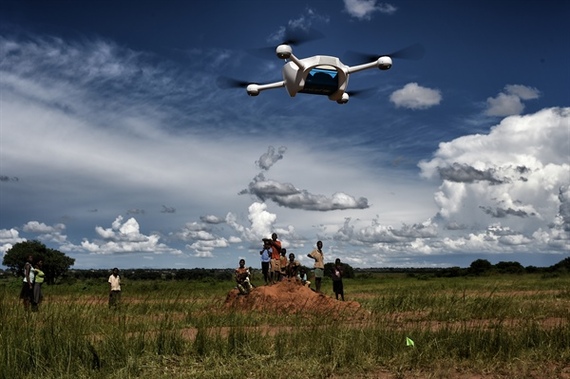By Smeldy Ramirez and Svante Persson

Smeldy Ramirez manages a $20 million portfolio of technical assistance projects and entrepreneurial investments for the Multilateral Investment Fund in the Dominican Republic. His areas of expertise include social innovation, finance inclusion, and development metrics.
The evolution of information and communications technologies late last century enabled the development of new military weapons guided by onboard computers, like the Tomahawk cruise missile, which were first used during the 1991 Gulf War. These missiles were the precursors to what would become the first unmanned aerial vehicles (UAVs), today known as drones, which are piloted by remote control or onboard computers and began doing military reconnaissance flights in the late 1990s.
Whereas cruise missiles were a one-way ticket, drones could fly more hours remotely, return to base, and receive new missions. Drones joined nuclear energy, the Internet, and GPS navigation systems as military creations that have been widely adopted for commercial use. Drones became mainstream at the end of the last decade, mostly due to the development of electro-mechanical systems that were created after the production costs of small components of mobile technology lowered, because of the widespread demand for smartphones.
By 2013, smaller drones begun to be used commercially for recreational purposes. The use of drones is now taking off in many different ways--including as humanitarian tools and for social innovation projects.
It's projected that by 2035, drones will surpass the number of piloted aircrafts, according to a recent study by the firm Oliver Wyman. Another study, by PricewaterhouseCoopers, notes that labor costs and services that can be replaced by the use of these devices account for about $127 billion today, and that the main sectors that will be affected are infrastructure, agriculture, and transportation. For example, drones can survey agricultural lands and help producers make more efficient use of seeds, fertilizer and water.
Drones useful as tools for humanitarian and social innovation projects
Recent pilot projects in different parts of the world have proved that drones can be successfully used as humanitarian tools in the areas of environmental protection and disaster relief, and to enable social innovation projects:
- The Amazon Conservation Association uses drones to monitor illegal mining and logging in the Peruvian Amazon, to prevent deforestation.
- In disaster relief, drones can conduct search-and-rescue operations after accidents or natural disasters have struck, and can also better predict where hurricanes will strike.
- As for social innovation, drones can deliver vaccines to rural mountainous areas of the world that are inaccessible to medical teams, and can collect samples from patients much faster than by other means of transport. Matternet, a Silicon Valley-based drone transportation development company, has launched pilot projects in Bhutan and Malawi with the support of organizations such as Doctors without Borders and UNICEF. Soon, Matternet will be testing similar initiatives in the Dominican Republic, in partnership with the Multilateral Investment Fund of the Inter-American Development Bank Group. This particular project may prove that drones can lower the costs of medical transportation between different remote locations.
Legal and ethical issues surrounding the use of drones
Despite their obvious attraction, the use of drones poses some serious legal, financial, and practical challenges. Therefore, lawmakers and public safety officials must try to balance the benefits provided with the protection of public safety, civil liberties, and privacy rights. The issues involve:
- Public safety. Drones are small and hard to detect for radar and air traffic controllers, who sometimes mistake them for large birds. Drones have been found flying dangerously close to commercial aircraft, violating aeronautical rules. Increasingly common "hobby drones" fly in residential areas and even around landmarks such as the White House in Washington, D.C., prompting all sorts of safety concerns. Regulations for where drones can and cannot operate are needed.
- Privacy rights. Since drones can collect and store personally or commercially sensitive data, regulations are needed to avoid violations of individual rights to privacy.
- Intellectual property rights. The use of drones that are equipped with cameras is problematic, especially if the devices take photos of public events or public buildings.
- Insurance issues. Drones raise new questions for the insurance industry, especially regarding property damage and liability. If a drone fell on a person or a car, industry experts say that in most cases, a standard homeowner's policy or optional comprehensive insurance policy would cover any damages.
- Ethical concerns. The United Nations has raised the concern that it could be problematic using commercial drones in conflict zones, since they would be hard to distinguish from military drones.
Svante Persson
Svante Persson has led projects for the Multilateral Investment Fund on water and sanitation, early childhood development and nutrition, and climate adaptation and resilience. He has a master's degree in economics from Lund University in Sweden and wrote his thesis about economic reforms in Cuba.
From the Multilateral Investment Fund Trends blog
